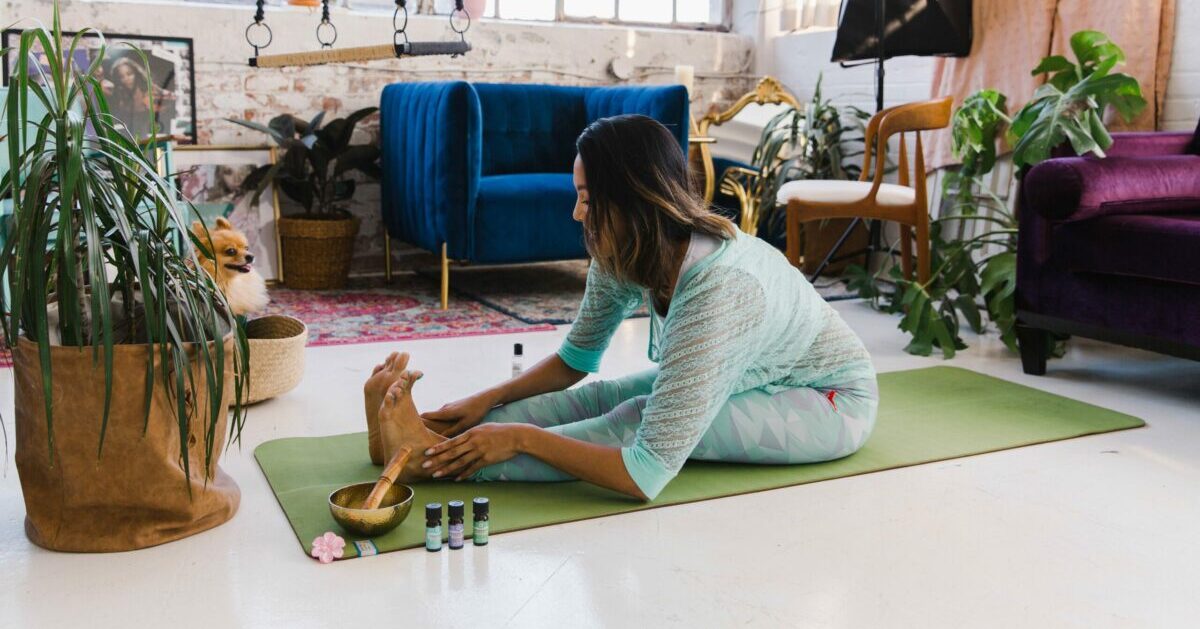Listen to this article:
Quick Tip: Create a serene and inspiring home yoga space with these 8 essential design elements.
Here are 8 yoga room decor ideas and essential elements for designing a personalized home yoga space that offers the same bliss of a studio, at a fraction of the cost.
From the moment I walked in, I felt a rush of peacefulness. Incense burned softly, dim warm lights and Himalayan salt lamps glowed all around, and a big beautiful tapestry covered the wall.
I felt ready to dive into my practice with complete presence and a grounding force.
Isn’t that the vibe we all crave when we arrive at our yoga mats? It feels like we can melt into our practice and forget about everything else.
Contents
Why Do You Need a Dedicated Yoga Room?
Asana practice should be done in a sacred, soothing place that brings us into a peaceful state of mind, far from the stress of the outside world.
Elements like light, color, scent, and visual arts have an incredible ability to switch your brain into “yoga mode”. Whether you are seeking stress relief, a sweaty workout, a spiritual connection, or all of the above, a special yoga space sets the mood for accomplishing your goals.
A dedicated yoga room (or part of a room) offers the same bliss of a yoga studio without the cost, commute or crowds. Your home yoga space is your special realm to get creative and align your environment with your goals and intentions.
Yoga Room Decor Ideas for an Inspiring Home Yoga Space
#1- De-Clutter the Space
Organization is essential for a yoga space that brings you into a calm, relaxed state of mind. The Feng Shui concept of “saucha” means clean and uncluttered, and it is used in yoga studios all around the world.
A cluttered space yields a cluttered mind, so it is important to remove anything that doesn’t serve a purpose. Use only decorations that are inspiring or functional, and take out everything else! This will reduce overwhelm and even encourage you to do yoga more often. Use wooden shelves to hold yoga and meditation books, a woven basket for yoga mats and towels, and hanging hooks for various straps and accessories.
#2- Incorporate Nature & Plants
Bring nature in with plants or terrariums. Trailing golden pathos vines, potted succulents, or mossy glass terrariums are lovely options for a low-lighting space. Snake plant, Boston fern, and English ivy offer air purification and diversity.
If you don’t have any nearby windows, consider bringing in some beautiful branches or driftwood, rocks or crystals, or even dried flowers to invite Mother Earth’s healing energy.
#3- The Best Colors for a Yoga Room
Muted, calm colors are the best for any relaxing space. Think sage green, soft lavender, pastel blue, blush pink, peach orange, or crisp white. Avoid harsh colors like red or bright yellow, which can cause anxiety or stress.
To keep your yoga space healthy for both you and the planet, always use VOC-free eco-friendly paint from brands like ECOS Paints or Benjamin Moore Natura line.
#4- Zen Mood Lighting
Many yoga studios have started incorporating colored light therapy to activate certain parts of the brain during different parts of a yoga flow. And there is real science to back it up.
Red and orange lighting motivates during high-intensity Ashtanga style poses.
Pink and green lights are more calming for deep stretches and yin yoga.
Blue light is excellent for focus and deep meditation.
Choose dimmable LED strip lights and color-changing mood lights. Add a special, mystical vibe to your space with warm hanging lanterns and Himalayan salt lamps.
#5- Candles, Scents & Essential Oils
The scent is a powerful grounding force. Have you noticed how the smell of certain foods can awaken childhood memories from decades ago? This is the same psychology we can use to train our brains to reach a state of peacefulness when we enter our yoga room.
Essential oil diffusers and natural candles are vital elements for a yoga space. You can even use different scents that coincide with specific chakras or intentions. For example, jasmine and lavender are associated with the crown chakra, while patchouli and cinnamon awaken the root chakra.
A burn bundle of healing herbs can be used to smudge or clear the energy before your practice, try to avoid the endangered white sage (commonly used in most sage bundles) and opt for sagebrush, incense, rosemary, or other fragrant herbs native to your region.
#6- Tapestry & Inspirational Posters
Mandalas, patterns, and photos of natural places will bring a completely different energy to the walls of your yoga sanctuary. Yogic, Ayurvedic, and Zen posters can serve as inspirational guides for your practice. Tapestries, or hanging textile art, goes a step further to add a mystical feeling to the room. If you don’t have a full room dedicated to yoga, you can also hang tapestries and curtains from the ceiling to section off a private yoga corner.
#7- Crystals, Statues & Treasures
No yoga room is complete without the energy and beauty of crystals. Choose crystals based on your personal practice goals. For example, Jade brings peace and serenity to the space, while amethyst promotes stability and patience. Rose quartz is the stone of compassion and self-love, while citrine is associated with prosperity and abundance.
The spiritual yogi can take the decor one step further by creating a small altar of crystals, miniature statues, and other treasures to ignite the soul and bring renewed vigor to asana practice.
#8- Mirrors for Alignment
Staying properly aligned during asana practice is vital for avoiding injuries and building stability. Mirrors complete the yoga studio vibe at a fraction of the price. As a bonus, they make even a small corner feel more open and free-flowing.
Creating a Calm Atmosphere
When I consider what sets a yoga space apart, it’s not the decorations; it’s the feel. Many experts emphasize the importance of establishing an ambiance. This is an aspect we have yet to explore. Let’s delve into it.
The Power of Peaceful Sounds
To begin with, take into account the experience in your yoga area. While silence is often preferred, introducing background music or the gentle murmur of a water element can enhance the sense of tranquility. Think about incorporating a fountain or playing soothing melodies. These can help block out distractions.
The Sensory Experience
Moving on, let’s discuss the aspects. The texture of your yoga mat, the sensation of the floor beneath you, and even the room’s temperature can impact your practice. Opt for a mat that feels underfoot and provides grip for your hands. If your space feels chilly think about adding a rug or using a heater to create an environment. Remember, establishing a peaceful setting involves engaging all your senses to support your yoga routine effectively. It’s, about striking that balance that enables you to turn inward and discover serenity.
Unlock the Importance of Sound in Your Yoga Space
When discussing the decoration of a yoga room we often emphasize the aspect. However, have you considered the significance of sound? Not just any sound, The kind that enriches your yoga practice. I’ve discovered that incorporating elements that impact the experience can truly enhance a yoga environment.
The Influence of Soundscapes
Crafting a soundscape can be as straightforward as including a water feature. The soothing sound of trickling water fosters a sense of tranquility and aids in concentration during meditation. It’s akin to being close to a stream within your own living space.
Embracing Silence
Conversely think about soundproofing options. It’s not for professional music studios. In a household having the ability to block out noise is invaluable. Simple fixes like curtains or tapestries can help absorb disturbances. This way your yoga room transforms into a retreat of quietness.
Integrating components or establishing an atmosphere may not be the initial consideration for yoga room décor. Nevertheless, it can make a difference. It’s all, about curating an ambiance that engages all your senses elevating your practice to a level. Believe me, once you recognize the impact of sound your yoga journey will reach depths.
Varieties of Sound Features
Consider including a small water feature for its calming effect with the gentle flow of water. Wind chimes or singing bowls can also add a layer of peace. These sounds aid in maintaining focus and presence during your practice.
Musical Elements and Chants
Playing soft instrumental music or nature sounds can establish the mood for your session. You may also experiment with chanting or listening to mantras to enhance your spiritual connection and enrich your practice.
Singing Bowls for Eliminating Mental & Physical Stress
These bowls produce resonant sounds and vibrations that are believed to have profound effects on the mind and body, helping to eliminate stress and promote overall well-being. Singing bowls create sounds and vibrations when struck or rubbed with a mallet. These sounds are rich in harmonic overtones, which can induce a state of deep relaxation and meditation. The vibrations from the bowl resonate through the body, helping to balance the energy centers, or chakras, and promote a sense of calm and tranquility.
Creating a Quiet Environment
For those residing in noisy surroundings, soundproofing your yoga area is beneficial. Utilizing thick curtains, carpets, and acoustic panels can help minimize external disturbances. This ensures that your space remains a haven of tranquility.
Integrating sound into your yoga environment can elevate the quality of your practice by engaging another sensory dimension, making it more welcoming and peaceful.
Personal Testimony
In my practice, integrating sound therapy has been truly transformative. The gentle resonance of a singing bowl has had an immense impact, aiding in concentration and deepening my meditation practice.
I feel the soothing vibrations coursing through me, bringing a feeling of calm and harmony.
Incorporating sound therapy into your yoga space can elevate your sessions. It’s a straightforward yet impactful method to enrich your yoga practice. Why not give it a shot and notice the positive impact it has?
Design with Intention
We are so excited to hear about your beautiful new yoga room! But, before you get started, I encourage you to set your intention. Write down 3-5 key results you want to get out of this room. More time to yourself? A space to disconnect? Stress-relief? Less back pain?
Once you identify your goals take a few minutes on your mat or meditation bolster to close your eyes and visualize the magical space you will create and how you will feel when you walk into that space.
Take a few deep breaths, and get designing. This is YOUR creative space to flow and release.
Namaste!
Pop quiz! 🧘🤔
Using bright colors like red in a yoga room can cause anxiety.
Essential oils and natural candles are unnecessary in a yoga room.
Mirrors in a yoga room can help with proper alignment during asana practice.
FAQs
How do I make yoga space in my bedroom? What should be in a yoga room?
A yoga room should incorporate functional organization for mats, towels, straps, and accessories, as well as inspirational elements like mood lighting, tapestries, posters, incense, mirrors, and crystals.
How do I set up a yoga room at home?
Setting up a home yoga room is as simple as de-cluttering the space, adding natural elements, painting the walls, adding mood lighting, and hanging tapestries or inspirational posters. Here are some inspirational photos and tips…
What is the best color for a yoga room?
Muted, calm colors are the best for any relaxing space. Think soft lavender, pastel blue, blush pink, or crisp white. Use VOC-free eco-friendly paint to keep your yoga space healthy for both you and the planet.
How do I make yoga space in my bedroom?
A yoga space can be as small as corner in a bedroom. Section it off with tapestries and flowing curtains, then add mood lighting, a small mirror, organization, and meditative decor.







